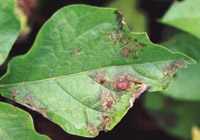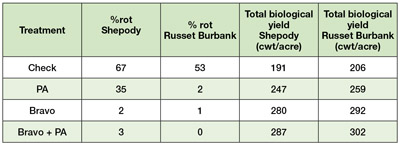
Features
Production
Research
Coming to terms with potato storage rots
September 16, 2010 By Lukie Pieters
Since 2005, a research team led by Dr. Rick Peters (Agriculture and
Agri-Food Canada, Charlottetown) has been conducting a number of trials
to examine the efficacy of phosphorous acid-based products (PA) for
control of pink rot and late blight tuber rot, and more recently also
for control of foliar late blight
Since 2005, a research team led by Dr. Rick Peters (Agriculture and Agri-Food Canada, Charlottetown) has been conducting a number of trials to examine the efficacy of phosphorous acid-based products (PA) for control of pink rot and late blight tuber rot, and more recently also for control of foliar late blight. These products are mono- and dibasic sodium, potassium or ammonium salts of phosphorous acid.
 |
|
| Dr. Rick Peters has been conducting a number of trials to examine the efficacy of phosphorous acid-based products for control of late blight tuber rot. Advertisement
|
“When applied (as a foliar) or as a root drench, these products can move systemically within the plant,” Dr. Peters explained. “An added bonus is that these products have a low environmental risk, compared to some of the more toxic protectant fungicides. They can act by directly inhibiting the growth and reproduction of the pathogen, but we also have acquired recent evidence that applying phosphorous acid to the foliage can stimulate the production of natural defence chemicals within the potato plant that make it less susceptible to disease.”
During harvest operations, pathogen spores can be splashed from diseased to healthy tubers before they enter storage, resulting in potential rot during storage. According to Dr. Peters, earlier trials in New Brunswick and Prince Edward Island showed that complete suppression of late blight tuber rot and pink rot caused by these splashed spores could be achieved when the PA-based products are applied as a post-harvest spray to potatoes entering storage.
“It should be noted, however, that tubers already infected in the field could not be cured with this approach,” he said. “Also, it is important to apply the spray as soon after harvest as possible (preferably within six hours of harvest) to prevent the spores from germinating and infecting the tubers.”
During the 2005 and 2006 growing seasons, several field trials were conducted in New Brunswick and Prince Edward Island to compare PA-based products, applied as a foliar, with in-furrow application of Ridomil® Gold 480EC (metalaxyl-m), to test the efficacy of these products for controlling late blight and pink rot.
“We found that foliar application of PA provided excellent control of both late blight and pink rot in tubers, which was equal to or better than that found with metalaxyl-m,” Dr. Peters said. Higher rates of foliar PA application provided better tuber rot control than did lower rates, but a rate of approximately five litres of product per hectare was determined to be an appropriate choice.
 |
|
| More recently, Dr. Rick Peters has been examining phosphorous acid-based products for control of foliar late blight. |
Application of PA after pathogen inoculation was generally less effective than application prior to inoculation. Prevention thus seemed better than cure. It was also found that at least three applications during the growing season were needed to confer disease control. The researchers observed no phytotoxicity. As well, tubers from plants receiving PA in the field were less susceptible to disease than control tubers when the researchers inoculated the tubers with the pathogens after harvest. In this way, tubers from plants receiving PA in the field enter storage with a significant level of disease resistance.
Replicated field trials were established at the Cavendish Farms research farm in Prince Edward Island during the 2007, 2008 and 2009 seasons. The initiation of late blight in the field plots was dependent on wind-blown spores from nearby natural field infections.
The field experiments were established to assess the effect of a phosphorous acid-based commercial product, ConfineTM alone, as well as in combination with Bravo® (chlorothalonil), to suppress the development of late blight in the foliage of both Shepody and Russet Burbank cultivars.
After the first evidence of disease symptoms in the plots, the research team assessed the crop for foliar disease on a weekly basis thereafter. The effect of the fungicide treatments on tuber rot, at harvest and after storage also was assessed. Finally, the researchers took healthy tubers from each of the plots (10 tubers from each plot) and inoculated these with either P. infestans (US-8 strain) or P. erythroseptica (PEI strain). These tubers were then stored at 15 C and 95 per cent relative humidity for two to three weeks to encourage disease development. After post-harvest inoculation and incubation, tubers were rated for the incidence and severity of pink rot and late blight tuber rot.
Dr. Peters’ research team found that data was similar in all years of the study. In the check plots, late blight symptoms developed more quickly in the foliage of Shepody plants than in Russet Burbank plants. The most extensive disease development occurred in the check plots. Within two weeks after detection in the check plots, symptoms started to appear in plots treated with PA. Later in the season, a slight amount of foliage damage caused by late blight occurred in the plots treated with Bravo® and Bravo® plus PA.
When tubers were graded at harvest, rot was most extensive in the tubers from the check plots. As well, rot was more extensive in Shepody tubers than in Russet Burbank tubers. Although extensive foliar blight eventually developed in foliage of plants sprayed with PA alone, significantly less tuber rot was observed in these plots compared to the check plots. Very little tuber rot was observed in plots where plants had been treated with Bravo® alone or Bravo® plus PA. (See Table 1.)
 |
|
| Table 1. Effect of fungicide treatments on tuber rot at harvest and potato yields.
|
“Following post-harvest inoculation, healthy tubers from plots receiving PA during the field season were significantly more resistant to the development of pink rot and late blight tuber rot in storage,” Dr. Peters remarked.
“Our studies indicate that PA-based products can provide significant disease control benefits when incorporated into a late blight and pink rot management program,” Dr. Peters said. “PA, when applied alone, delayed foliar disease epidemic development in our studies. This could be an important benefit for growers during those times when application of protectant products in a timely fashion is difficult due to adverse weather conditions.”
The combination of PA with Bravo® was a particularly effective approach, likely due to the synergies captured by combining a truly systemic (PA) with a protectant (Bravo®) product. In addition to achieving foliar disease suppression, the suppression of tuber rot achieved by incorporating a PA-based product into a late blight/pink rot management program must also be underscored, according to Dr. Peters.
The commercial product ConfineTM (mixture of mono- and di-potassium salts of phosphorous acid) is the only PA-based fungicide currently registered in Canada. It is registered for post-harvest treatment of potato tubers. An emergency registration for foliar application of ConfineTM for late blight control was granted in 2009; however, it was not approved until it was too late in the season for meaningful application. Growers in Canada likely will have full access to this product in the near future.
“An added benefit of PA is its relatively low toxicity,” Dr. Peters mentioned. “Since PA-based products are recognized as being environmentally friendly, their incorporation into disease management programs may significantly reduce the usage of other fungicides. In fact, we have conducted additional studies which indicate that the rate of protectant fungicide (Bravo®) can be reduced by 50 per cent and still achieve excellent disease control if PA is included in the disease management program. In this way, environmental risk of pesticide application, particularly to aquatic organisms, can be lessened,” Dr. Peters concluded.
Print this page